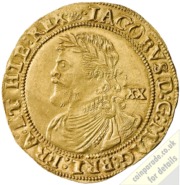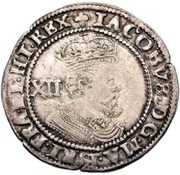
 The 1620 Gold Laurel - James I (MM Rose)
The 1620 Gold Laurel - James I (MM Rose)The third version of the Laurel. Laurels were only minted during the reign of King James I.
When James VI of Scotland became James I of England and began to create a united kingdom, he introduced a gold coin known as the 'Unite'. In 1619 it was decided to replace the Unite with a lighter coin known as the 'Laurel', which was minted in 22 carat 'Crown' gold. The Laurel was still valued at 20 shillings (one Pound). The half-laurel and quarter-laurel were also made.
There are five main versions of the Laurel and the coin does not display a date. This particular coin carries the mint mark of a Rose and that indicates the first coinage struck between 24 June 1620 and 8 June 1621.
Compare with the 1619 Gold Laurel – James I (MM Spur Rowel).
The Obverse shows the first bust of King James I which is described as the third small rounded head. The ties are slightly wider apart compared to previous versions. The 'XX' to the right is a mark of value (20 shillings). The King faces left on this coin but he faces right on some of his other coins.
 The Reverse shows a crowned quartered shield.
The Reverse shows a crowned quartered shield.This coin is graded as Very Fine and is expensive (probably £2,000-4,000+).
Image credit: The Royal Mint
Mintage: Not known
Minted at The Royal Mint
More information (monarch, year, mint, country, category) can be found below coin listings.
Below are some coins currently being offered on eBay. As an eBay Partner, We may be compensated if you make a purchase.
List items on:
List items on:
James I (1603-1625)
 James was born on 19 June 1566 at Edinburgh Castle, the son of Mary, Queen of Scots, and Henry Stuart (Lord Darnley) in the House of Stuart. He was James VI of Scotland and James I of England but combined the thrones from his Coronation on 24 March 1603.
James was born on 19 June 1566 at Edinburgh Castle, the son of Mary, Queen of Scots, and Henry Stuart (Lord Darnley) in the House of Stuart. He was James VI of Scotland and James I of England but combined the thrones from his Coronation on 24 March 1603.Despite a few problems (such as the Gunpowder Plot in 1605), James left a legacy of a fairly peaceful, low taxation reign. He died from natural causes on 27 March 1625, aged 58. James was Father of Charles I.
On coins, James I is usually written as Latin: IACOBVS I.
Category: Laurel
The Laurel was an English gold coin with a value of 20 shillings or one pound. Laurels were only minted during the reign of King James I and were named as the obverse shows James I wearing a Laurel.When James VI of Scotland became James I of England and began to create a united kingdom, he introduced a gold coin known as the 'Unite'. In 1619 it was decided to replace the Unite with a lighter coin known as the 'Laurel', which was minted in 22 carat 'Crown' gold. The Laurel was still valued at 20 shillings (one Pound). The half-laurel and quarter-laurel were also made.
There are five main versions of the Laurel and the coin does not display a date but does usually have a mint mark to aid dating.
Which Mint: The Royal Mint
The Royal Mint is the designated place for the UK to mint coins. It dates back well over 1000 years and is a Government-owned company. Formed in the reign of Alfred the Great about the year 886, during the period 1279-1812 it was generally referred to as The Tower Mint as it was housed at the Tower of London. The Master of The Royal Mint has included famous figures such as Sir Isaac Newton.
Since 2010 it has operated as Royal Mint Ltd, a company owned by HM Treasury, under an exclusive contract to supply all coinage for the UK although it also produces medals and coins for other countries. It is currently located at Llantrisant, Wales.
Country of Origin: United Kingdom
The United Kingdom (UK) is the Union of England, Scotland, Wales and Northern Ireland. It is often refered to as Great Britain (GBR). It has a long, rich history. The orignal coinage was Pounds, Shillings and Pence but since decimalisation on 15 February 1971, it is £1 = 100p, that is One Pound = 100 pence. The coinage of the UK is also a long history, the Royal Mint being established as long ago as 886AD when coins were hammered. Today there is perhaps 30 billion coins in circulation, and many (numismatic) collectors coins and sets are issued frequently in gold, silver and other metals.








